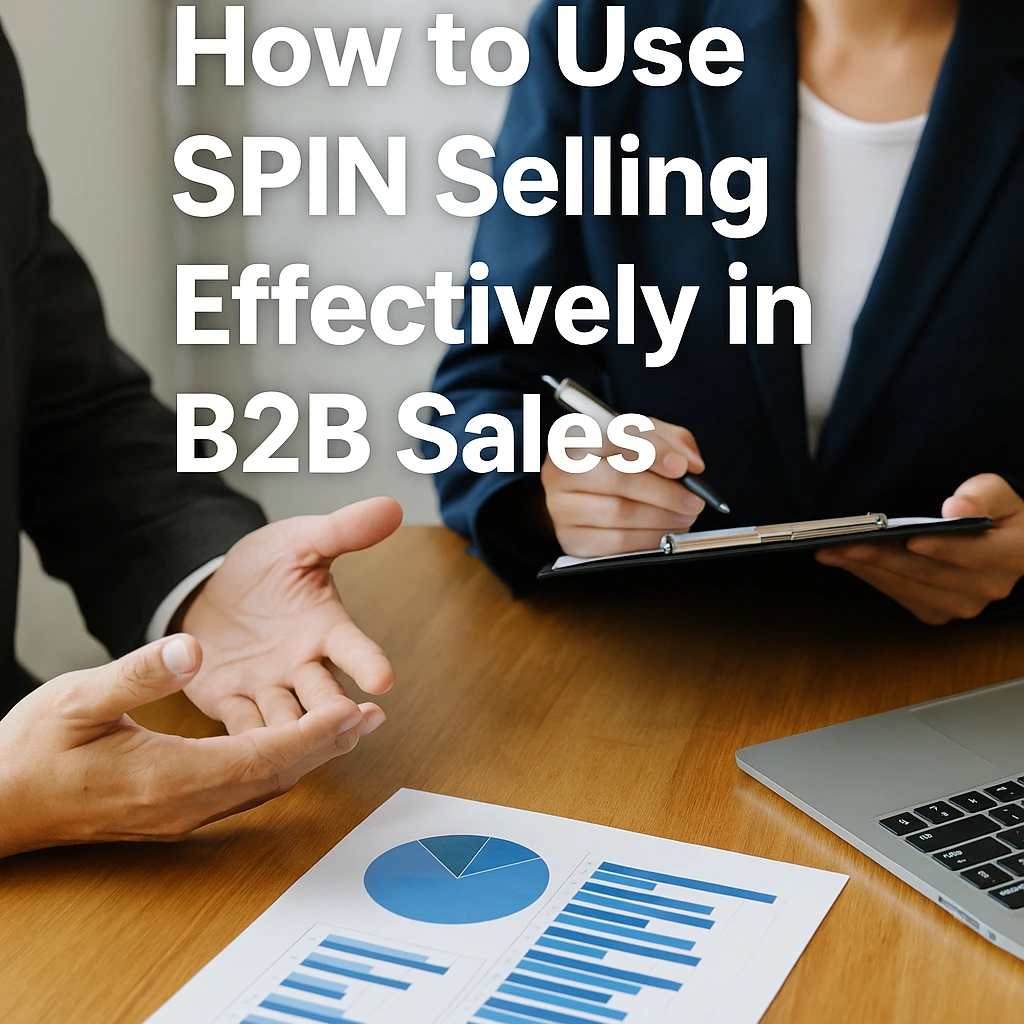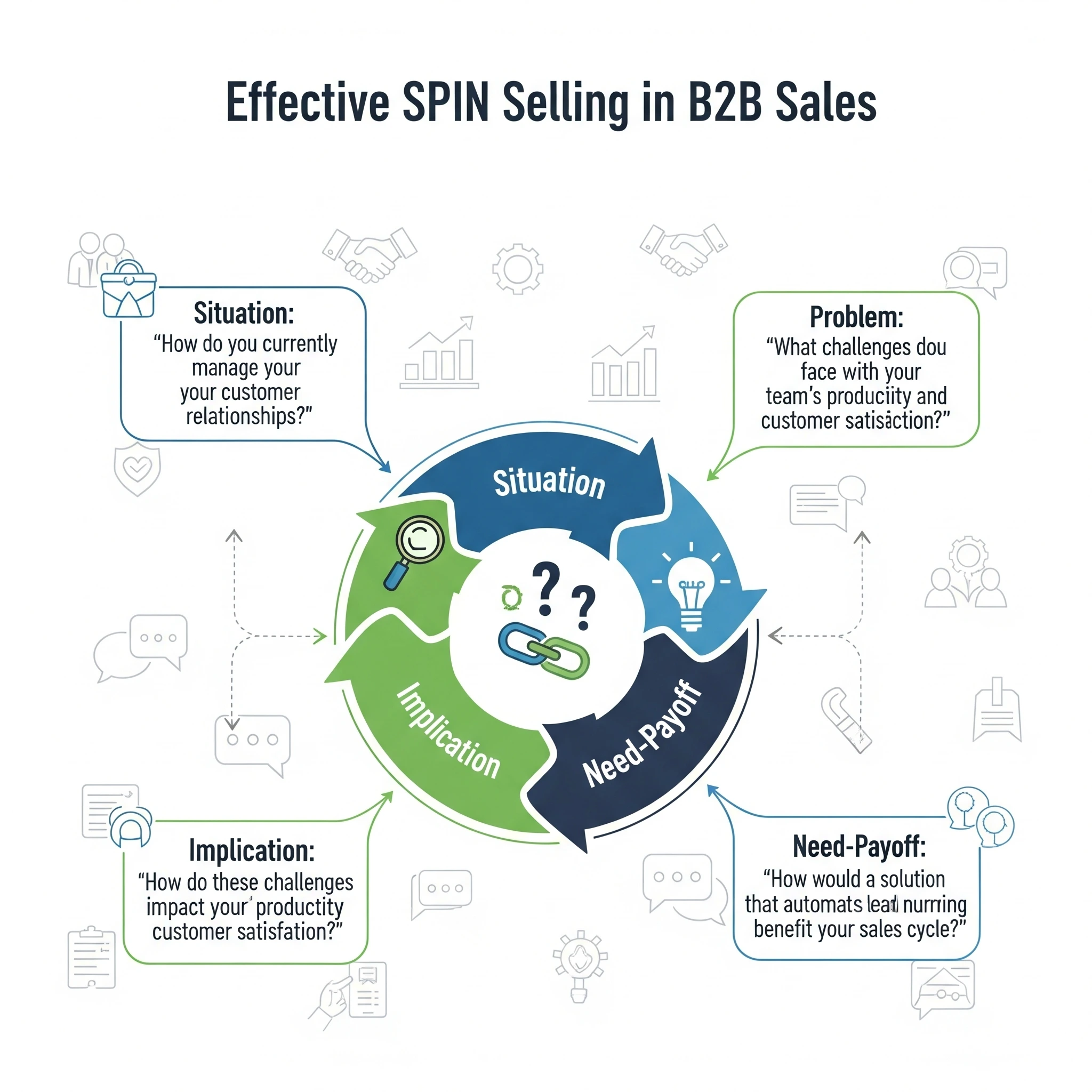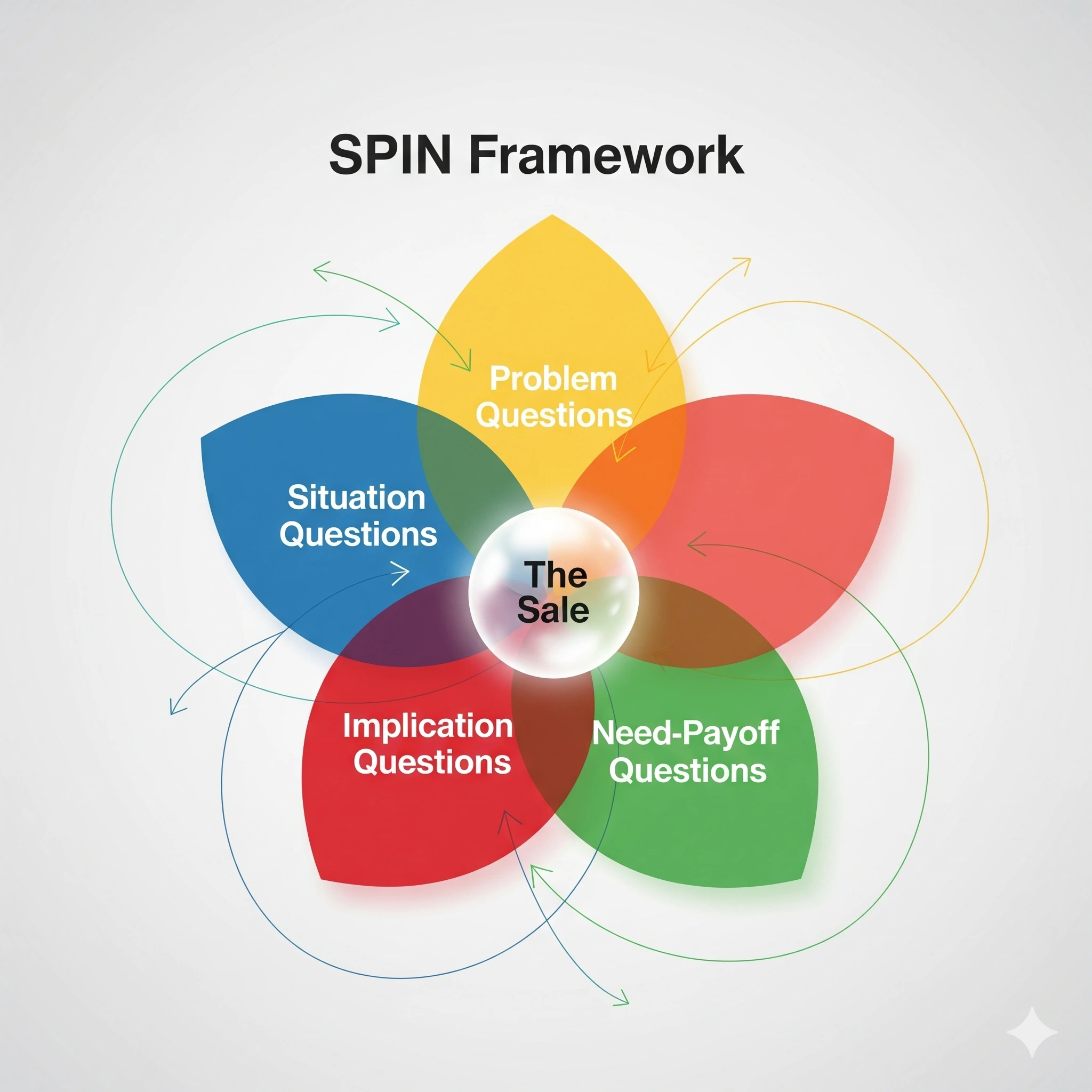
How to Use SPIN Selling Effectively in B2B Sales
Summary:
SPIN Selling is a time-tested sales framework that helps B2B sales teams uncover customer needs, build trust, and drive conversions through structured conversations. Unlike traditional sales approaches that focus on pitching products, SPIN emphasizes understanding the buyer’s situation, identifying problems, exploring the implications, and highlighting the value of solutions. By following this approach, sales professionals can transform discovery calls into consultative conversations that resonate with modern, informed buyers.
In today’s competitive B2B landscape, leveraging SPIN Selling effectively requires preparation, active listening, and personalized engagement. Sales reps who integrate data from CRM platforms, use insights to ask meaningful questions, and practice role-playing scenarios are more likely to guide prospects through the buyer’s journey successfully. This approach not only improves conversion rates but also builds long-term customer relationships, positioning reps as trusted advisors rather than aggressive sellers.

SPIN Selling is an effective sales model that remains popular in the B2B sales approach of today. Originated by Neil Rackham, it has withstood the test of time since it emphasizes asking proper questions instead of applying forceful sales closing approaches. With buyers being inundated with information these days, SPIN Selling enables sales professionals to break through the confusion by establishing trust, finding real pain points, and moving prospects towards effective solutions.
Today's sales process is not about selling features, it's about having consultative selling conversations that are buyer-focused. SPIN Selling succeeds because it turns the conversation into a joint problem-solving activity. By using Situation, Problem, Implication, and Need-Payoff to organize questions, sales reps are able to understand customers more, connect problems to quantifiable business effect, and introduce their solution as the natural solution.
Whether you’re selling SaaS, professional services, or enterprise solutions, SPIN Selling is highly adaptable. Let’s explore its origins, its stages, and most importantly, how to use SPIN Selling effectively in today’s B2B landscape with the help of modern tools like PowerDialer.ai.
What is SPIN Selling?

The Origins of SPIN Selling
SPIN Selling emerged after studying over 35,000 sales calls. The study indicated that effective salespeople didn't use "hard closes." Rather, they employed questions that led the prospect to identify their needs independently. The model was a paradigm shift in sales coaching, away from persuasion and toward effective customer psychology-inspired sales conversations.
Why SPIN Still Matters in Modern B2B Sales
Although today's customers do their research online prior to interacting with sales reps, SPIN Selling integrates perfectly into today's buyer's process. Why? Because it reflects the way buyers think, looking for problems, thinking about consequences, and weighing solutions. Rather than pushing a pitch, SPIN allows sellers to be thought leaders, which is a critical element in high-stakes, long-cycle B2B transactions.
Basic Principles of SPIN Selling
- Keep the focus on the buyer, not the product.
- Ask layered, perceptive questions.
- Establish trust prior to offering solutions.
- Identify underlying customer pain points.
- Lead buyers to self-discover value.
The 4 Steps of SPIN Selling

1. Situation Questions
Situation questions are the beginning of any SPIN selling dialogue. They assist you in collecting vital information regarding the buyer's existing environment, procedures, and equipment. This stage can be considered fact-finding without flooding the prospect. The trick is to be relevant and purposeful, ask only what you can't discover with research. Strong situation questions build rapport and set the stage for uncovering underlying issues later. If you rush through this step or make it seem like an interrogation, you can risk losing the trust of the buyer immediately. Done correctly, it puts the stage out for a seamless transition into problem finding.
Asking the Right Background Questions
Your background questions need to be specific, open-ended, and business-relevant. For instance:
- "What CRM system do you currently use?"
- "How does your sales team get organized?"
- "How do you currently measure outbound success?"
These set context and point out where inefficiency may lie.
Avoiding Situation Question Errors
Don't ask obvious or bland questions such as "What industry are you in?", that indicates that you're not prepared. Another error is asking multiple questions in a row so that it resembles a list. Make it concise, meaningful, and always connect the answer back to some possibility of a gap or opportunity.
2. Problem Questions
Problem questions ask more probing questions related to the customer's pain points, frustration, and bottlenecks. This is where you're moving from having only a grasp of the situation to pointing out what's not going well. This is where consultative selling truly starts because you're revealing underlying pain points that the buyer themselves might not be aware of. Good problem questions open the door for you to be empathetic, build credibility, and subtly position your solution against their requirements. By not defining actual problems, you're at risk of selling features that don't strike a chord.
Identifying Customer Pain Points
A few examples of good problem questions are:
- "Where are you running into roadblocks around lead conversion?"
- "What are the challenges you encounter when coaching new reps?"
- "Are there steps that are taking longer than they should?"
These leave buyers space to speak up about frustrations they've quietly suffered through and being heard and understood.
Taking Little Problems and Making Them Big Opportunities
Even minor inefficiencies can become top priority when reframed. It might seem insignificant, for example, if sales reps are spending hours dialing by hand. But when it is reframed as lost revenue, reduced team productivity, and lost deals, it becomes a compelling reason to transform. Your job is to get prospects to link minor annoyances to big business outcomes.
3. Implication Questions
Implication questions are where you crank up the heat. Here you work with the issues you've identified so far and make the prospect understand the serious business ramifications of leaving them unsolved. These questions turn the conversation from inconvenience to crisis. Your objective is to make the prospects understand that inaction comes with a price tag, not only financially but also in terms of missed opportunities, customer loss, and competitive loss. If executed effectively, implication questions heighten the urgency of the buyer to buy and make you a valued advisor instead of a pestering salesperson.
Connecting Problems to Business Impact
You can pose the following kinds of questions:
- "If your team is going to continue to waste 10 hours a week manually dialing, how is that impacting your quarterly goals?"
- "What if lead response time remains slow for the next six months?"
- "How will this affect customer retention rates?"
These place emphasis on the domino effect of unresolved issues and build a sense of urgency.
Example Implication Questions That Work
- "What if this inefficiency continues during the next fiscal year?"
- "How does this delay affect customer satisfaction ratings?"
- "What is the long-term price tag of not fixing this problem?"
These kinds of questions make the buyer appreciate the real magnitude of the problem and so are much more receptive to listening to your solution.
4. Need-Payoff Questions
Need-payoff questions are where you move the conversation from pain to potential. Instead of talking about what's wrong, you lead the prospect into thinking about what might be right if the problem was fixed. Need-payoff questions focus on value creation, and you get the buyer to say in their own words why fixing the problem is important. Getting them to say the benefits in their own words lowers resistance, and you can close naturally. This phase is important because it shifts the dialogue from negative (pain) to positive (opportunity). Purchasers exit exhilarated by possibility rather than burdened by issue.
Taking the Dialogue from Cost to Value
Examples include:
- "If you were able to reduce lead response time in half, how would that impact sales performance?"
- "What would it do for your team if they spent less time dialing and more time speaking with live prospects?"
- "If customer complaints are reduced by 30%, how would that affect retention?"
These assist the prospect in envisioning an improved future state in which the problems are fixed.
How Need-Payoff Questions Drive Conversions
The elegance of this phase is that the customer sells themselves. When they discuss benefits using their own language, more revenue, more satisfied reps, better efficiency, the sale is no longer so much about persuading and is instead about affirming. That's why need-payoff questions are regarded as among the strongest weapons in the SPIN selling method. They turn sales discussions into joint problem-solving.
Why SPIN Selling Is Successful in Today's B2B Sales Process
Aligning with the New-Gen Buyer's Journey
Current buyers are intelligent, conducting their own research months in advance of meeting with a salesperson. They don't need a sales pitch; they need a trusted advisor to help them navigate through tough decisions. SPIN selling easily aligns with this journey through the design of discovery calls that reveal authentic needs and align solutions with buyer objectives.
Key Points:
- Insights are more important to modern buyers than product specifications.
- SPIN questions reveal underlying needs buyers might not express initially.
- Discovery-based conversations create deeper connections.
- Assists sales reps to match up with every step of the buyer journey.
Building Trust with Consultative Selling
Trust is the currency of B2B sales, and SPIN builds it organically. Asking questions shows a deep concern for the buyer's issues rather than jamming them with a pitch. It positions reps as advisors who collaborate to find solutions instead of pushy sellers trying to meet quotas.
Key Points:
- Demonstrates empathy by placing the buyer's pain points first.
- Positions reps as problem-solving partners.
- Establishes credibility early in the relationship.
- Leads to longer-term customer loyalty.
Creating Value Instead of Pushing Products
Perhaps the largest sales mistake is to bury buyers with features. SPIN prevents this by emphasizing results and quantifiable business outcomes. Rather than having buyers "buy a product," salespeople assist buyers in "buying better performance" or "buying time savings." This change turns the dialogue into value-based decision-making.
Key Points:
- Puts the dialogue away from features and toward ROI.
- Highlights quantifiable payoffs such as revenue increase or time reduction.
- Compare your solution to commodity competitors.
- Provokes investment based on influence, not only cost.
Practical Tips to Implement SPIN Selling Successfully
Do Your Homework Prior to the Call
Effective SPIN selling relies on preparation. Going into a conversation without elementary information is throwing away valuable time and credibility. Knowing the company, industry, and decision-maker in advance guarantees your questions are acute, pertinent, and interesting. This prevents redundancy and makes you sound like a respected counselor instead of a script reader.
Key Points:
- Use LinkedIn, Google, and company sites for background.
- Customize situation questions to their own industry.
- Don't ask what you should already know.
- Preparation generates instant credibility with buyers.
Personalize Questions with CRM Data
The modern salesperson has a winning edge with tools such as PowerDialer.ai and sophisticated CRMs. These tools offer data on customer history, likes, and behaviors. By incorporating these facts into your SPIN model, you make questions increasingly relevant and personalized. Personalization respects the buyer's time and engages the conversation.
Key Points:
- Use CRM analytics to learn from previous conversations.
- Cite actual data in your SPIN questions.
- Personalization increases response rates and trust.
- Tools like PowerDialer.ai automate data-driven outreach.
Balance Between Listening and Asking
The secret of SPIN selling is listening as much, if not more, than questioning. A harmonious dialogue ensures the customer feels heard and appreciated. Adhering to the 60/40 rule, listening 60%, asking 40%, enables you to gain deeper insights and maintain dialogue fluidity. When customers speak more, they share information that directly points to better need-payoff opportunities.
Key Points:
- Don't make SPIN into a checklist inquiry.
- Listen attentively for clues to ask more forceful follow-ups.
- Bring out the buyers' challenges.
- Make it a conversation, not a soliloquy.
Role-Play SPIN Situations with Your Team
Rehearsal makes execution sharp. Role-playing sales calls with your team instills confidence and gets reps to own the SPIN process. Practicing various scenarios, cold calls, product presentations, or renewal conversations, equips reps with real-life objections and curveballs. Teams who practice together cultivate consistency and effectiveness in real sales conversations.
Key Points:
- Role-play both simple and difficult scenarios.
- Swap roles (rep and buyer) for insight.
- Utilize coaching feedback for improving questioning technique.
- Establish confidence prior to going live with prospects.
Mistakes to Avoid in SPIN Selling
Information Overloading Customers with Questions
There are too many back-to-back questions, overwhelming the buyers and making them feel interrogated. Instead, ask fewer but more effective questions. A discovery call should be casual and exploratory in nature, and not mechanical or coercive. Showing respect for the buyer's time makes them more inclined to respond.
Key Points:
- Make the calls conversational, not a survey type.
- Prioritize quality questions over quantity.
- Don't ask rapid-fire questions out of context.
Asking General Rather Than Insightful Questions
Open-ended, generic questions such as "What's your biggest challenge?" tend to elicit shallow answers. Thoughtful, targeted questions reveal underlying issues and lead to productive conversations. To do this, make your questions specific to the prospect's job, business, or known pain points. This makes you a consultant, not a generic salesperson.
Key Points:
- Shun generic, obvious questions.
- Employ data and research to pose targeted questions.
- Thought-provoking questions expose underlying pain points.
Rushing to Close Without Identifying Needs
Leaping into pitching without fully investigating the buyer's situation, problems, and implications short-circuits the SPIN process. The technique is intended to reveal needs before matching them with solutions. Having faith in the framework makes it intuitive and customer-led, rather than coercive.
Important Points:
- Don't bypass the discovery and problem stages.
- Allow the buyer to express value in need-payoff.
- Closing needs to be a solution, not coercion.
- Tools & Technology to Support SPIN Selling
Using PowerDialer.ai for Data-Driven Questioning
PowerDialer.ai gives sales teams real-time analytics, enabling them to customize SPIN questions on calls. Surface customer behaviors and interaction history enable reps to steer conversations with accuracy. This saves effort and makes each question data-backed.
Key Points:
- Real-time insights give questions an edge.
- Aids in high-value prospect prioritization.
- Enhances call efficiency and effectiveness.
Making the Most of Sales Enablement Platforms
Sales enablement software such as HubSpot and SalesLoft automate the whole SPIN process. They offer templates, automate follow-ups, and monitor engagement metrics. Through these platforms, reps can consistently scale SPIN conversations without sacrificing personalization.
Key Points:
- Automates processes without compromising SPIN.
- Monitors buyer engagement for optimal follow-up timing.
- Enhances consistency across sales teams.
CRM Insights for Personalized SPIN Conversations
Contemporary CRMs hold goldmines of customer data, purchase history, communication records, and interaction patterns. These become game-changers in equipping reps to pose more incisive situations, problem, implication, and need-payoff questions. By integrating SPIN with CRM data, discussions become more goal-oriented and results-driven.
Key Points:
- CRM analytics reveal behavioral patterns.
- Enables ultra-personalized SPIN discussions.
- Boosts conversion rates with evidence-based approaches.
Case Study: SPIN Selling in Action
A SaaS business with low conversion rates used SPIN Selling.
- Situation: "What tools are you using for outbound calls?"
- Problem: The client confessed that manual dialing was costing time.
- Implication: "What does this lost time cost your sales team quarterly?"
- Need-Payoff: "How would automation improve your close rates?"
Result: The business incorporated PowerDialer.ai and enhanced conversions by 30% in six months. Their sales representatives had more time closing and less time manually dialing.
Conclusion
SPIN Selling continues to be an effective B2B selling approach because it's based on consultative selling and consumer psychology. Rather than being pushy, it enables salespeople to dig up the pain points, establish business relevance, and lead buyers to relevant solutions. In today's new-age selling process, SPIN is not merely applicable, it's necessary.
If your sales team is still having trouble with generic conversations and lost opportunities, it's time to adopt SPIN Selling with contemporary tools.
Schedule a demo with PowerDialer.ai and observe how data-backed SPIN conversations can revolutionize your sales performance.
FAQs
Q1: Is SPIN selling obsolete?
No, SPIN Selling is extremely relevant in today's B2B sales due to its compatibility with consultative selling.
Q2: Is SPIN selling applicable in cold calls?
Yes, SPIN is applicable in cold calls when questions are tailored and pertinent to the prospect's case.
Q3: How is SPIN selling unique compared to other approaches?
In contrast to high-pressure sales closing methods, SPIN emphasizes discovery and problem-solving.
Q4: Can SPIN selling be applied using tools?
The questions are human-generated, but tools such as PowerDialer.ai assist in structuring, tailoring, and scaling outreach.
Q5: Is SPIN only for B2B?
SPIN is mostly applied in B2B but can also be used in high-value B2C situations.
